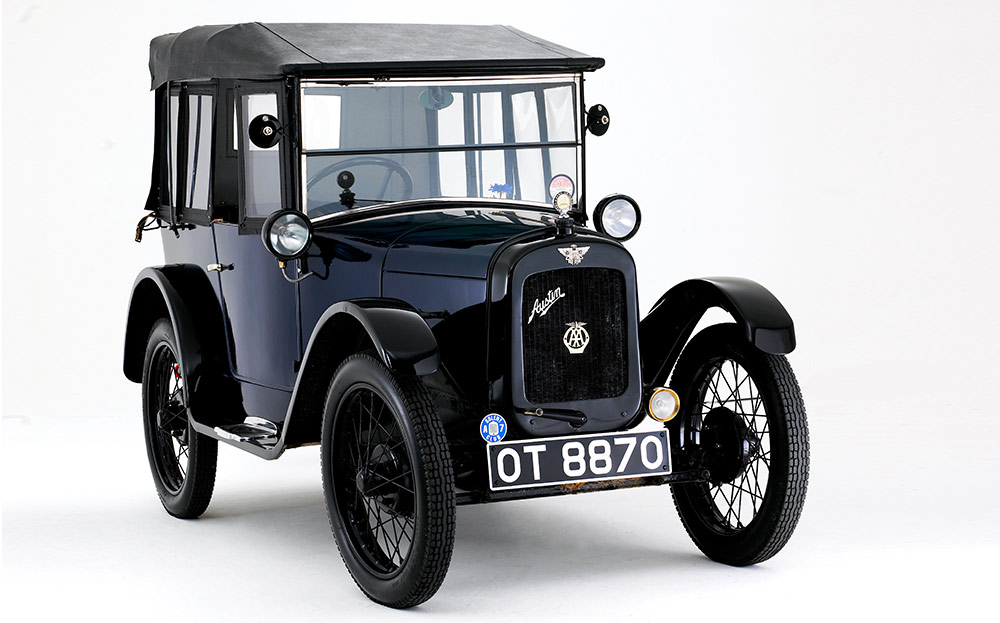None Seven

The descriptions of the Classic Cars in the Directory were partly generated or supplemented with the help of artificial intelligence (AI). The content may occasionally not always be entirely accurate or factually correct despite careful checking.
The Austin Seven was a small, yet capable car produced by the Austin Motor Company between 1922 and 1939. It was designed to be an affordable car for the masses, and it quickly became one of the most popular vehicles of its time. The Austin Seven featured a range of technical details that contributed to its success.
The car was powered by an 848cc side-valve engine that produced 10 horsepower at 2,400 rpm. It was a four-cylinder engine with a bore and stroke of 63.5mm x 76.2mm, and it featured a single Solex carburetor to deliver fuel to the engine. The engine was mated to a four-speed manual transmission with a floor-mounted gear selector. The Austin Seven was capable of reaching a top speed of 50 mph (80 km/h) and it could accelerate from 0-50 mph in 28 seconds.
The suspension system of the Austin Seven was comprised of semi-elliptic leaf springs and hydraulic dampers. This allowed for a smooth ride and good handling on rough roads. The brakes were mechanical and operated on all four wheels. The front brakes were 8-inch drums, while the rear brakes were 7-inch drums.
The chassis of the Austin Seven was a simple ladder frame design that was made from channel steel. The body was made from steel and featured open or closed designs. The open designs included a roadster, tourer, and sports versions. The closed designs included the saloon, coupe, and van versions. The dimensions of the car varied slightly depending on the body style, but the overall length was around 3.2 meters (10.5 feet), and the weight was approximately 660 kg (1,455 lbs).
The Austin Seven also featured a range of advanced technical details for its time. The car had a 6-volt electrical system, and it featured an electric starter and lights. It also had an adjustable steering wheel and seats, which was a unique feature at the time. The fuel tank had a capacity of 6.5 gallons (30 liters), and the car had a range of approximately 250 miles (400 km) on a full tank.
In conclusion, the Austin Seven was a small but capable car that was designed to be affordable for the masses. Its technical details were advanced for its time, and it featured a range of modern features that contributed to its success. Despite its small size and power, the Austin Seven was a reliable and popular car, and it remains a much-loved classic today.
Milestones
1. 1922: Introduction of the Austin Seven at the London Motor Show. 2. 1923: Production begins at the Austin Motor Company in Longbridge, Birmingham. 3. 1924: Launch of the Chummy model, which becomes the most popular variant. 4. 1926: Introduction of the Box and Ruby models, which offer larger and more powerful engines. 5. 1927: Production of the Swallow Two-seater sports car begins. 6. 1928: The Seven becomes the first car to be driven around the world (by a team led by brothers Jean and Roger Crawfurd). 7. 1932: The Big Seven model is launched, featuring a larger engine and improved suspension. 8. 1934: Production of the Austin 7 ceases after over 290,000 units were made.Technical
- Manufacturer: Austin Motor Company - Production period: 1922-1939 - Engine: 747cc, four-cylinder, side-valve - Power output: 10-17 hp - Top speed: 50-60 mph (80-96 km/h) - Transmission: Four-speed manual - Brakes: Mechanical drum brakes on all four wheels - Suspension: Rigid axle with semi-elliptical springs at the front, quarter-elliptic springs at the rear - Steering: Worm and roller - Wheelbase: 6 ft 3 in (1.91 m) - Length: 9 ft 2 in (2.79 m) - Width: 4 ft 0 in (1.22 m) - Weight: 900-1,200 lbs (408-544 kg) - Fuel consumption: 35-50 mpg (6.7-4.7 L/100km) - Variants: Tourer, Sports, Box Saloon, Fabric Saloon, Ruby, Opal, Pearl, Nippy, Ulster, Big Seven - Production volume: ~290,000 - Notable features: Simple and reliable design, low cost, lightweight, easy to maintain, popular among British motorists in the 1920s and 1930s.